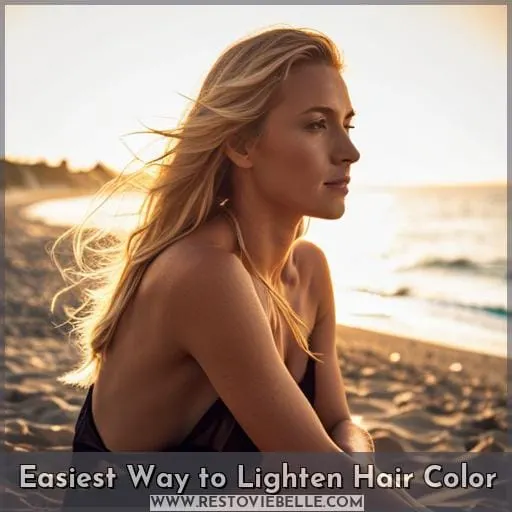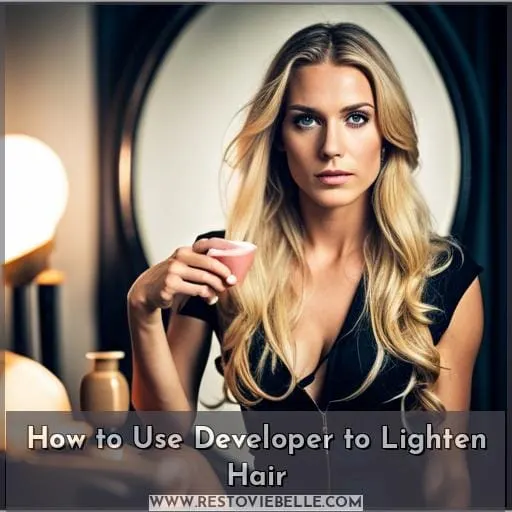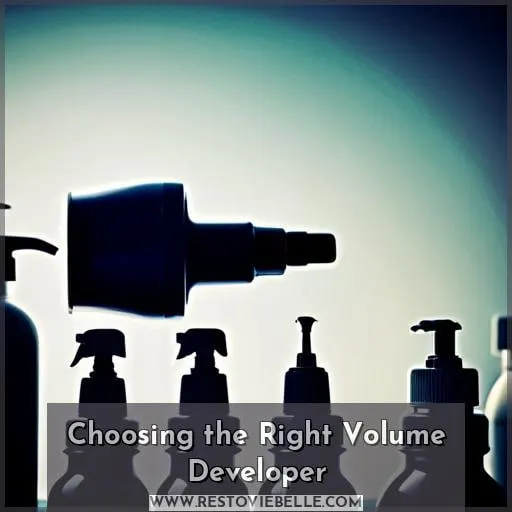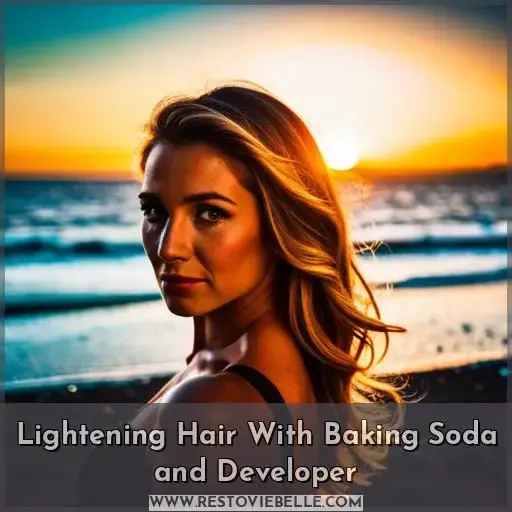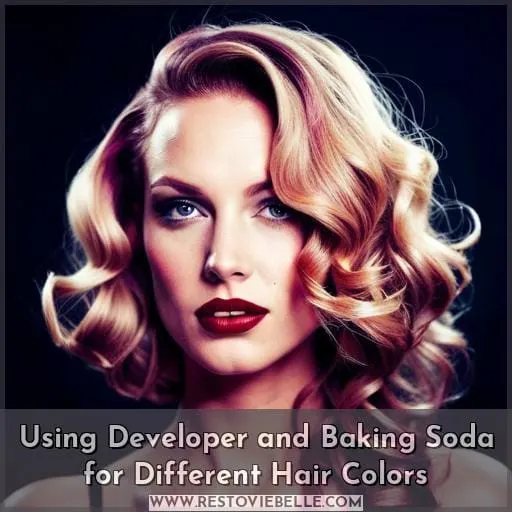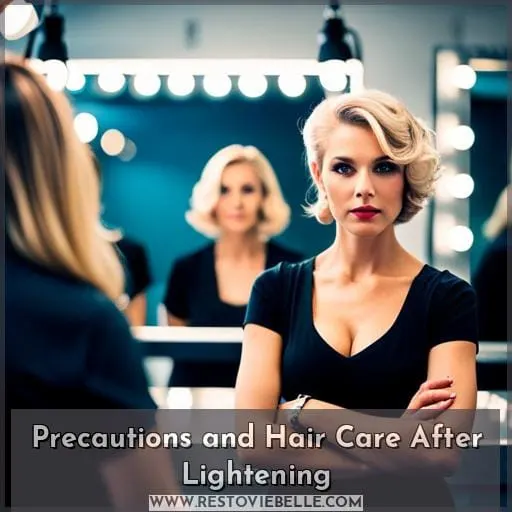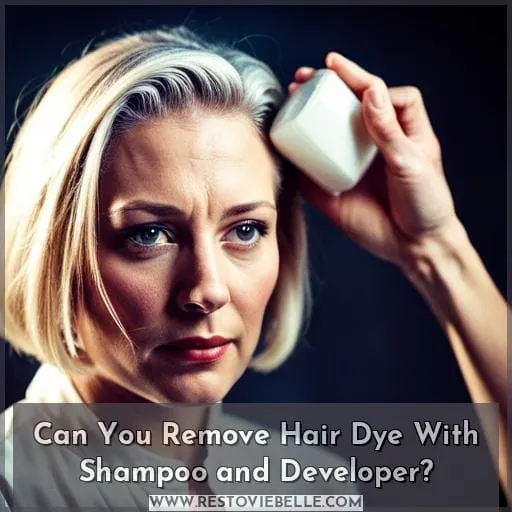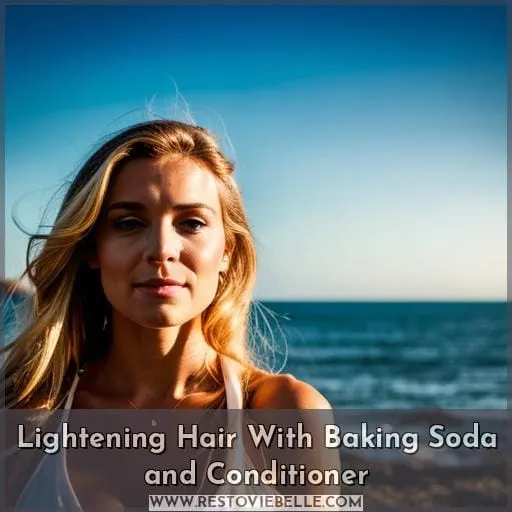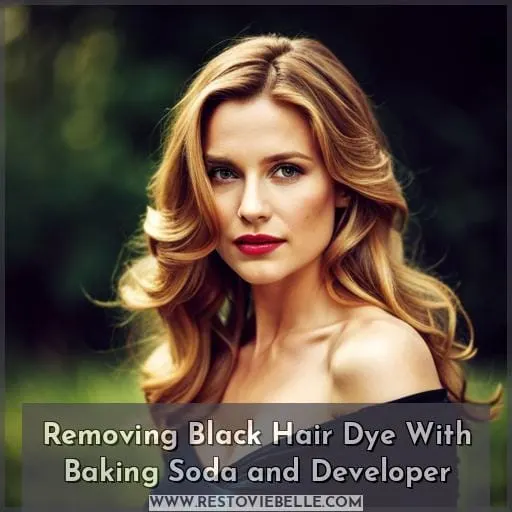This site is supported by our readers. We may earn a commission, at no cost to you, if you purchase through links.
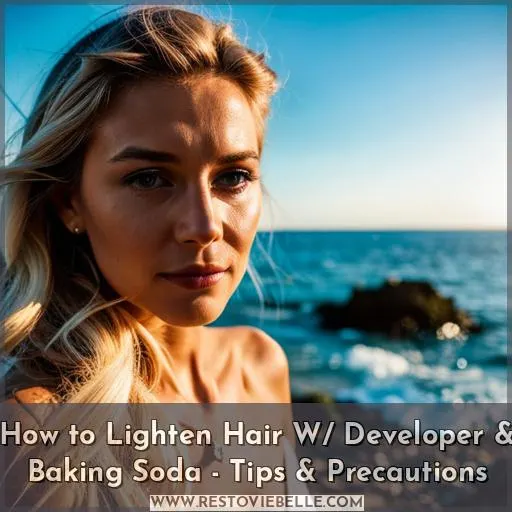 Are you looking for an easier and more natural way to lighten your hair color? Let’s say you have dark brown hair and want it a few shades lighter than its current hue.
Are you looking for an easier and more natural way to lighten your hair color? Let’s say you have dark brown hair and want it a few shades lighter than its current hue.
By mixing baking soda with developer, you can safely lighten your locks without having to visit the salon or use harsh chemicals that could cause damage. Read on for tips on how best to go about this process as well as precautions when using developer and baking soda together.
From choosing the correct volume of developer to alternative techniques like soap capping and removing black dye with this method.
Table Of Contents
- Key Takeaways
- Easiest Way to Lighten Hair Color
- How to Use Developer to Lighten Hair
- Choosing the Right Volume Developer
- Lightening Hair With Baking Soda and Developer
- Alternative Techniques: Soap Capping
- Using Developer and Baking Soda for Different Hair Colors
- Precautions and Hair Care After Lightening
- Can You Remove Hair Dye With Shampoo and Developer?
- Lightening Hair With Baking Soda and Conditioner
- Removing Black Hair Dye With Baking Soda and Developer
- Frequently Asked Questions (FAQs)
- Conclusion
Key Takeaways
- Choose the appropriate developer volume based on the desired level of lightening.
- Perform a strand test before applying the mixture to the entire hair.
- Use a shower cap to cover the hair during the processing time.
- Rinse the hair thoroughly after processing and use nourishing shampoo and conditioner for maintenance.
Easiest Way to Lighten Hair Color
Learning how to gently alter your hair color with natural ingredients can be a rewarding process. Baking soda and developer are two key components for achieving desired results without harsh chemicals.
It’s important to choose the right developer volume – 10 or 20 for subtle lifts, 30 for more lift, and 40 for drastic changes – and mix it with baking soda accordingly.
Make sure you perform a strand test before applying the mixture evenly on dry hair while wearing gloves. Cover your hair with a shower cap and follow the recommended time (20-45 mins). Monitor the processing carefully as higher volumes may be damaging if left too long in your hair.
After rinsing thoroughly, use a nourishing shampoo and conditioner to help maintain healthy locks! With patience required through multiple applications depending on the initial hue, of course, you’ll soon have beautiful lighter tresses that are chemical-free!
How to Use Developer to Lighten Hair
Discover how to utilize a developer and baking soda with ease to effortlessly enhance your hair’s hue.
To ensure success, do a strand test before application and open cuticles by using hydrogen peroxide. Apply the mixture section by section on clean, dry hair for 30-60 mins then rinse thoroughly with lukewarm water followed by nourishing shampoo and deep conditioner for hair health.
Opt for higher volume developers, such as 20 or 30, but monitor processing time carefully to avoid over-treatment and damage.
Remember that patience is key as multiple applications might be needed. Seek professional help if necessary, but also maintain regular care routines for the overall wellness of your tresses!
Choosing the Right Volume Developer
Choosing the Right Volume Developer
Choosing the right volume developer is essential for successful lightening, so make sure to opt for a 20 or 30 volume strength. Developer opens hair cuticles and breaks down pigments; 10 or 20 gives subtle lift, while 30 adds more dramatic change and 40 can lead to over-treatment.
Safety precautions should also be taken: perform strand tests, avoid higher volumes of developer if possible, and deep condition after each use.
Here are some tips when selecting a developer:
- Aim for either a 20 or 30 volume strength depending on desired results
- Consider safety first by performing a strand test before full application
- Adjust baking soda based on the texture of your hair type
- Monitor processing time throughout the treatment session
These easy steps will help you achieve desired results without damaging your precious locks! Taking into account these considerations allows one to create beautiful looks with balanced protection against harsh chemicals found in many other alternatives like bleach.
Lightening Hair With Baking Soda and Developer
Lighten your hair with a natural approach by using baking soda and developer. When mixing the two, opt for a 1:3 ratio of baking soda to developer, depending on your desired level of lift. Apply the mixture section by section onto clean, dry hair and cover it with a shower cap before rinsing it after 30-60 minutes.
With proper application techniques, you can achieve lighter shades without damaging the health of your hair when done correctly.
Proper Mixture Ratio of Baking Soda and Developer
Mixing the correct ratio of baking soda and developer is crucial for achieving your desired hair lightening results. Before applying the mixture, perform a strand test and adjust the ratio according to the texture and color of your hair.
For a subtle lift, opt for a 10 or 20 volume developer. If you want more drastic changes, use a 30 volume developer, but avoid using a 40 volume developer as it can be too damaging. Combine 1 cup of baking soda with 3 tbsp of hydrogen peroxide, then apply the mixture evenly on dry hair – don’t forget to wear gloves! Keep track of the processing time (20-45 mins) and rinse thoroughly once done.
Application and Processing Time
Glide your gloved hands through the paste, timing each section as you go for optimal lightening. To avoid hair damage, it’s important to perform a strand test before proceeding.
Depending on the desired color lift and level of processing needed, 20-45 minutes should be sufficient to achieve results.
Afterward, use deep conditioning and nourishing shampoo/conditioner for hair health maintenance. For those with fine or dry hair looking for a more gradual change, soap capping may be an option.
With patience and proper care, you can enjoy liberation from harsh chemicals while achieving beautiful locks without any fuss!
Effects on Hair Health
Be mindful of the effects on your hair health when lightening with a developer and baking soda mixture. To prevent damage, select the right volume based on desired results. Perform strand tests to monitor processing time and use nourishing shampoo for pH balance.
Use natural alternatives, such as deep conditioning masks or hair brightening products made from household ingredients, to avoid harsh chemicals in lightening paste. Take necessary precautions like wearing gloves during the application process. Rinse thoroughly with lukewarm water after suggested times and opt for 20-30 volume developer over higher levels whenever possible.
Remember that patience is key to achieving desired results – multiple applications might be needed! Keep regular hair care routines consistent throughout this process. It will help you maintain overall healthy locks while still enjoying subtle changes in color without compromising the long-term health of strands.
Alternative Techniques: Soap Capping
Lightening hair at home with baking soda and developer is a process that requires careful consideration. The soap capping method offers an alternative to more drastic treatments, allowing gradual lightening over multiple sessions.
However, it may lead to dryness and damage in certain cases, such as fine or dry hair. Patience may be needed for desired results while maintaining regular hair care routines for overall health.
Process and Method
Slather on the perfect combination of developer and baking soda to get your desired results! For natural hair lightening, choose a 10-40 volume developer.
Do a strand test before applying, then apply evenly using gloves for protection. Monitor processing time: 20-45 minutes should do it! Rinse thoroughly with lukewarm water afterwards and deep condition or moisturize hair to keep it healthy.
Soap capping offers gradual lightening over multiple sessions but can dry out fine or dry locks, so be wary of that method too! Keep patient; you’ll achieve beautiful results without harsh chemicals in no time at all.
Pros and Cons
Lift your locks to a lighter shade with natural ingredients, but beware of the potential damages! Soap capping is an alternative technique that uses bleach and developer mixture. It offers gradual lightening over multiple sessions to achieve lighter shades, but may lead to dryness and damage – particularly with fine or dry hair.
Developer can open cuticles while higher volumes can be more damaging; deep conditioning after use is recommended, as well as strand tests prior to application.
Results and Hair Condition
Reach for the stars and your hair color will follow suit – with patience, multiple applications of natural ingredients like baking soda and developer may help you achieve desired results. Protect strands from damage by using protective products throughout each step; timing tips are essential to avoid over-treatment or dryness.
Plus, factor in hair type when selecting a developer level; if dye removal is necessary, opt for 30 volume versus higher levels.
Using Developer and Baking Soda for Different Hair Colors
You’re looking to lighten your hair color and you want to know the best way to use developer and baking soda. Depending on the shade of lift or lightening desired, a 20-volume developer is suited for subtle lift, 30 for more noticeable changes, while 40 might be needed for drastic transformations.
20 Volume Developer for Hair Color Lift
For subtle lightening, reach for a 20-volume developer to give your hair color an extra lift. This mild formula works best on darker natural colors and is suitable for achieving lighter shades.
For safe use, make sure you wear gloves while applying the mixture of developer and bleaching powder evenly over clean, dry hair.
Afterwards, follow up by deep conditioning your locks too. This will help keep your locks looking healthy and feeling nourished after dye removal or lightening tips are used.
With the right knowledge and safety precautions taken, you can achieve that desired warmth in color from a simple lift using a 20-volume developer mixed with baking soda!
30 Volume Developer for Hair Lightening
Boost your hair to a lighter shade with 30 volume developer and baking soda for maximum effect. Mix three tablespoons of hydrogen peroxide into one cup of baking soda. Then use it to cover strands evenly.
Twenty minutes is the suggested processing time, but keep an eye on your locks in case they need more or less care. Be sure not to over-treat them. Follow safety precautions when using any volume developer for natural lightening results without damage.
For stubborn hair dye, consider soap capping. However, watch out for dryness and breakage on fine or dry tresses! With patience and regular nourishing shampoo/conditioner routines, you can achieve the desired color lift while preserving hair health too!
40 Volume Developer for Drastic Changes
If you’re looking to make a drastic change, 40 volume developer is the way to go. But proceed with caution; higher volumes can cause more damage and should only be used if needed. Always perform a strand test before lightening your hair, as well as deep conditioning after use.
For optimal results, mix the developer with baking soda or bleaching powder for effective color lift.
Precautions and Hair Care After Lightening
When lightening your hair with baking soda and a developer, it’s important to be aware of the potential risks. Specifically, using too much baking soda can damage hair or cause scalp irritation, while strong developers may strip away natural color.
Therefore, it is essential to use both ingredients carefully and follow up with a neutralizing shampoo after lightening for the best results.
Neutralizing Shampoo After Lightening
After lightening your hair, using a neutralizing shampoo can help restore the pH balance of your locks and smooth them out like silk. Strand tests are vital before using hydrogen peroxide or 30 volume developer to ensure minimal damage.
Deep conditioning after use is essential for nourishing the hair color lift and protecting it from further stressors.
If you’re looking for a natural approach, try baking soda with 10-20 volumes instead; still perform strand tests first! For increased protection, opt for an antioxidant-rich formula containing botanical extracts that will also boost shine post-treatment.
Potential Hair Damage From Baking Soda and Developer
It’s important to be aware of potential hair damage when using a mixture of baking soda and developer, as it can leave your tresses dry or brittle. Protecting strands from such harsh chemicals is essential. Opt for ammonia-free dye alternatives and use heat protection products prior to application.
Hydrating masks work wonders after bleaching powder lightening with 30 volume developer. Regular deep conditioning helps prevent hair breakage and dryness. To avoid over-treatment during the process, monitor time closely.
Results vary depending on how long you keep the product in your hair. Rinse thoroughly with lukewarm water afterwards.
Can You Remove Hair Dye With Shampoo and Developer?
You can try to remove hair dye with shampoo and developer, but beware of the potential risks—a figurative gamble that could leave your locks looking like a hot mess. Developer is used for lightening or lifting color from hair strands. However, it’s best to stick to controlled levels such as 10-20 volume when using it on delicate tresses.
A higher concentration of 30-40 volume might be too harsh for some types of hair and cause damage or breakage. In addition to removing the color you want removed, it could also leave an uneven tone after application, which would require further corrections or alterations to achieve the desired look.
If you’re really set on trying this method, always perform a strand test first so you can monitor results without risking irreversible damage. It’s important that any product used for dye removal has low ammonia content while still being effective enough at breaking down pigments.
This allows only certain amounts of color lifting instead of leaving an uneven tone after application.
Lightening Hair With Baking Soda and Conditioner
Revitalize your locks with a natural mixture of hydrogen peroxide and baking soda for an effective yet gentle lightening treatment. To give you that desirable bleaching effect, use a developer of 10 to 20 volume strength for subtle lifting.
Mix the developer with the baking soda in equal proportions before applying it on clean, dry hair section by section.
Cover up your head using a shower cap while leaving it on for 30 to 60 minutes. Rinse off thoroughly and use nourishing shampoo as well as conditioner afterwards.
Monitor the processing time carefully to prevent over treating or damaging your hair due to higher volume developers used during the color lifting process, which can breakdown pigments in one’s hair quickly, leading to undesired results.
Removing Black Hair Dye With Baking Soda and Developer
If you’re looking to remove black hair dye with baking soda and developer, the key is to understand your specific hair type and color. The effects of conditioning will be particularly important for fine or dry hair as too much lightening can cause significant damage.
When selecting a developer, opt for 10-30 volume levels depending on how drastic of a change you’d like. Soap capping is an alternative if you want gradual results, but it may also lead to dryness or further damage, so consider that before starting this process.
It’s also essential to know your desired end result in order to reduce the risk of over-treating, which could cause breakage or brittleness due to its harsh nature.
Frequently Asked Questions (FAQs)
How long does it take to lighten hair with baking soda and developer?
Lighten your hair with baking soda and developer in as little as 30 minutes. Choose the correct developer volume for subtle to drastic changes, apply it evenly, and follow the suggested time frames for best results.
Is it safe to lighten hair with baking soda and developer?
Yes, lightening your hair with baking soda and developer is safe when done carefully. Follow safety precautions like using gloves and a shower cap, adjust the amount of baking soda based on your hair texture, and opt for 20-30 volume developer to ensure minimal damage.
Can I use baking soda and developer to lighten dyed hair?
Yes, you can use baking soda and developer to lighten dyed hair. Take it slow with the mixture, starting with a lower volume developer for gradual lift. Monitor the processing to avoid over-treatment and protect the health of your hair.
What is the best way to prevent hair damage when lightening?
Choose a lower volume developer, use baking soda in moderation, and monitor the process. Use gloves to avoid skin contact with chemicals and a shower cap to protect your hair.
What is the best developer volume for lightening hair?
For lightening hair, opt for a 20 or 30 volume developer. This will provide subtle to moderate lift without overtreating your locks.
Conclusion
Lightening your hair can be a safe and natural way to achieve your desired hair color with the help of baking soda and developer. Take the case of Jenn, who was able to achieve a subtle lift in her blonde hair by using a 10-volume developer and baking soda mixture.
If you’re looking for more drastic changes, you can opt for a 30 or 40-volume developer, but be sure to keep in mind that higher volume developers can be more damaging.
When using baking soda and developer to lighten your hair, use caution, perform strand tests, and follow the recommended processing times to avoid over-treatment. With the right approach, you can lighten your hair color with developer and baking soda in a safe and natural way.
